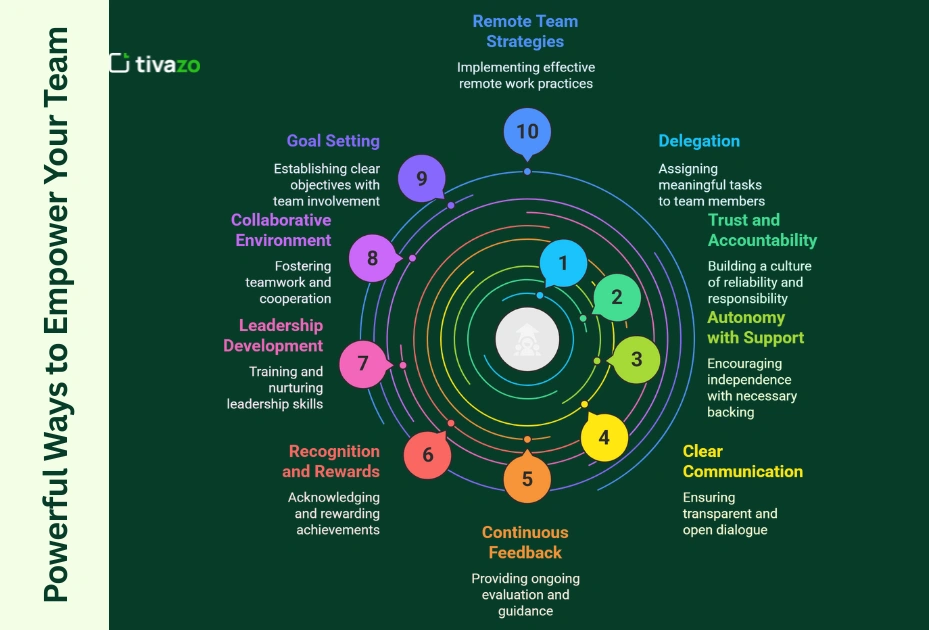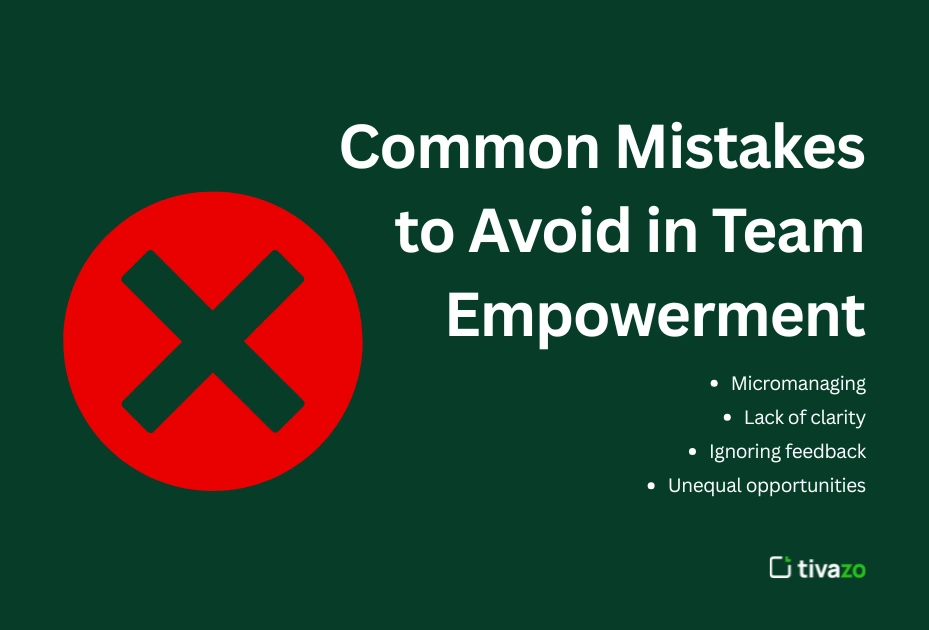In the fast-paced and competitive work climate today, businesses win when their team members feel trust and value which allows them to work in an empowered state. Team empowerment is not just a management buzzword; it’s a critical way to enhance morale, improve productivity, and promote enduring achievements.
When team members feel empowered, they will proactively lead, make better choices and identify ways to contribute to the organization’s vision. Having your team feel empowered doesn’t mean that you are giving up control as a leader – it means supporting an environment that allows your people to perform at their best while feeling free from fear and other constraints. Empowering your team does require, as a leader, having clarity and trust as well as consciously creating an environment in which your employees can develop.
In this blog, we will define what team empowerment means, discuss why it is important, and outline 10 impactful ways to empower your team as a leader, supporting your team even if you are working remotely! We want provide real, actionable guide for leading decisions regardless of whether you manage one small group or multiple departments. These tips can help you meaningfully lead, so that success isn’t an accident and you don’t have to depend on luck to achieve great results with your team.
Key Takeaways:
- What Is Team Empowerment and Why Does It Matter?
- Powerful Ways to Empower Your Team
- Benefits of Empowering Employees at Work
- Common Mistakes to Avoid in Team Empowerment
- Conclusion & Final Thoughts
- FAQs:
What Is Team Empowerment and Why Does It Matter?

Team empowerment is giving your people the authority, resources, and confidence to make a decision and take ownership of their work. It is about creating a trust-based, accountable environment where employees feel psychologically safe to speak up, innovate, and lead.
A big part of that is building a culture of team autonomy. That’s not to say letting people do whatever they want, but enabling them to contribute meaningfully to the organization while staying aligned with the goals, vision, and intent of the company. Empowered teams are often far more engaged, motivated, and loyal to the organization.
When employees feel empowered:
- They work with an ownership mindset (which drives performance outcomes)
- They collaborate better (which improves team dynamics, and workplace efficiency)
- They are more involved in decision-making (which fosters innovation and long-term sustainability)
So if you’re asking yourself how you can create empower your team members in the workplace, the answer is to move from command-and-control leadership to being supportive and trust-based.
10 Powerful Ways to Empower Your Team

Now that we are familiar with the definition of team empowerment and why it matters to have in any successful organization, we will look at how to make it happen. Empowering your team is not about making big gestures or showy actions, it is about having consistent and real actions that will provide people a voice, ownership and support.
The following 10 tactics will help you create a work culture where team members feel appreciated, trusted and inspired to be the best they can be while working together. Whether you are in charge of in-person teams or remote teams, these tactics will help you be a better leader and you can start to cultivate an environment of empowerment, autonomy, collaboration and purpose.
1. Delegate Meaningful Work Responsibility
One of the most effective ways to empower your team is to delegate responsibility that is meaningful and in alignment with team member’s strengths. Don’t simply give up tasks—give them work that requires ownership and gives a sense of accomplishment.
For example, if you are managing a marketing team, give one person the responsibility for next campaign, rather than just executing your plan. Provide them with the room to plan, execute and report. This level of delegation gives that individual a level of decision-making and builds confidence, while also giving your leadership potential to grow.
2. Build a Culture of Trust and Accountability
Trust and accountability form the foundation of everyone’s feeling of empowerment. If employees feel as though someone is looking over their shoulders at all times or are constantly watching them, they will hesitate to be a part of the solution.
Begin with transparency around what the expectations are and offering people the benefit of the doubt. When mistakes occur (and they will), accept those mistakes as learning moments. That fosters accountability and encourages a team of members who will take on their own results as their results and feel comfortable being part of a decision without fear.
3. Promote Autonomy with Support
Letting your team decide indicates that you are trusting them, but trust does not mean abandoning them. If they need support, be available, but don’t hover.
Establishing more autonomy for employees looks like:
- Letting them choose how to complete a task.
- Letting them seek a solution before coming to you asking for permission.
- Letting them develop their own mini-goals in a project.
By practicing this balance, you develop autonomy but support innovation.
4. Communicate Clearly and Disclose Information Transparently
Transparent and honest communication in the workplace is the bridge between leadership and employee empowerment. If your team is not aware of the “why” behind their decisions or tasks, they will never truly feel like they are a part of it and involved.
Have team check-in meetings routinely, disclose information openly, and listen to feedback. Communication is critical in establishing positive dynamics among the team. Clarity in communication leads to collaboration and execution.
5. Offer Continuous Feedback and Support
Feedback is the engine of development. A culture of empowering employees involves providing feedback and support continuously and ongoing—not just once a year at review time.
What can managers do to use feedback to empower their team:
- Provide feedback centered around behavior and results—not people’s personality.
- Recognize small wins.
- Ask for their feedback in return. Empowerment goes both ways.
Create a support and feedback loop to strengthen trust and support ongoing growth.
6. Empower Employees through Recognition and Rewards
People want to know that their work is of value. Employees recognizing accomplishments big and small can develop a positive motivation at work culture.
Rather than only saying you did a good job or fantastic work, you may be more effective by saying, “That client presentation was well done and used some nice visual data.” People want to be recognized. Publicly sharing recognition can help boost people’s confidence in their work and set the bar for others.
Recognition and reward are crucial to any empowering leadership approach.
7. Offer Leadership Development Training
If you want to have employees that are empowered you need to give them the skills to do so. Offer leadership workshops, communication training, or job-shadowing opportunities.
Leadership empowerment isn’t just for senior management. Everyone on the team should feel they have the potential to grow and lead from where they are.
Engaged employees are typically more empowered and productive. In fact, empowered teams are more engaged and better able to accept change.
8. Create a Collaborative Work Environment
Collaboration increases creativity and problem-solving. Therefore, teams should be encouraged to work in cross functional teams and share ideas freely.
A collaborative work environment includes the followings:
- Regular brainstorming sessions
- Cross-team projects
- Open discussions
Building a sense of teamwork, strength in numbers, and a shared vision creates an adaptable and empowered workforce.
9. Establish Clear Goals and Invite Teams to Participate in the Process
People are more engaged when they play a role in the journey. Instead of assigning tasks, you should have a discussion around the goal with your team and let them assist with the planning.
When employees contribute to defining what success looks like, they are more likely to feel a part of the process. This can lead to a team feeling like they are working towards a goal together, increased ownership, and ongoing habits of shared responsibility.
10. Empower Remote Teams Strategically
Empowering remote teams is different than in-house teams. When you are not working face-to-face, you must be intentional about establishing trust and autonomy.
The best practices for empowering remote teams:
- Leverage platforms that allow for asynchronous work and transparency (project management tools)
- Create flexible working hours with clear deliverables
- Schedule regular one-on-ones with the intention of support, not surveillance
Remote teams need autonomy, clear expectations, and praise—like any in-house team would! However, remote teams require even more intention.
Benefits of Empowering Employees at Work

The advantages of empowering employees go way beyond happier employees. When your team feels empowered, your entire organization experiences a cascading effect of positive results:
- Increased productivity: Employees own tasks and become more efficient.
- Increased morale: Empowerment, recognition, and trust promote satisfaction and loyalty.
- Increased innovation: When a team feels empowered, they have the confidence to share audacious ideas.
- Lower turnover: People stay where they are valued and their voice is heard.
- Increased collaboration: A sense of empowerment allows people to instinctively support their teammates and work in tandem.
In short, how team empowerment brings people up in morale and performance comes back to giving people a reason to care—about their job, about their teammates, about the broader mission.
Common Mistakes to Avoid in Team Empowerment

While empowering your team is generally positive, there are potential negatives associated with it. Here are some things to try and avoid:
- Micromanaging: You cannot empower employees and watch everything they do. You have to learn to let go a little and trust the process.
- Lack of clarity: Empowerment and no strings attached leads only to confusion. Make sure you align their freedom with clear expectations.
- Ignoring feedback: If you ask for employees for their opinions/input but then never do anything with it, employees will feel shut out.
- Unequal opportunities: Empowerment must be inclusive. All employees in the team must have that opportunity.
The key here is to empower your employees without micromanaging them, give them a structure but not restrictions.
Conclusion & Final Thoughts
Empowering your team isn’t about standing back and watching from a distance, it means standing up and pulling others up with you. It is a form of leadership that values trust, growth, and co-ownership. Empowering your team is not only going to impact individual performance, but also establish a healthy, collaborative workplace culture.
Seeing results from these 10 techniques is not a one-time solution but an ongoing practice of conscious leadership. The result? Teams feel more confident, more energized, and aligned with your vision. Empowered employees will go above and beyond, they will take initiative without being asked, and they will take ownership of your business objectives.
Seeing results from these 10 techniques is not a one-time solution but an ongoing practice of conscious leadership. The result? Teams feel more confident, more energized, and aligned with your vision. Empowered employees will go above and beyond, they will take initiative without being asked, and they will take ownership of your business objectives.
FAQs:
What is team empowerment?
Team empowerment means employees are given the authority, resources, trust, and independence to make decisions and own their work. Empowerment creates a culture where individuals believe they are capable, valued, and held accountable.
What are the four elements of team empowerment?
The four foundational elements include:
- Significance: Team members feel their work is meaningful and makes an impact.
- Independence: Employees can complete work with freedom to complete tasks how they deem appropriate.
- Confidence: The belief they can achieve.
- Influence: They can voice their views in decisions that impact their own work.
What does "empower your team" mean?
To empower your team means to assist and allow your team to operate independently, contribute, problem solve and make decisions. To guide, trust them, and remove unnecessary roadblocks to their success.
What are the benefits of employee empowerment?
Employees who are empowered will be more engaged, more productive and innovative. They will be more engaged, will contribute with more meaning and feel loyalty to the company, which will reduce turnover and strengthen workplace culture.
What are the benefits of empowerment?
At the organizational level, empowerment also leads to:
- Speed of decision-making
- Team morale
- Accountability
- Collaboration
- Adaptability and innovation




